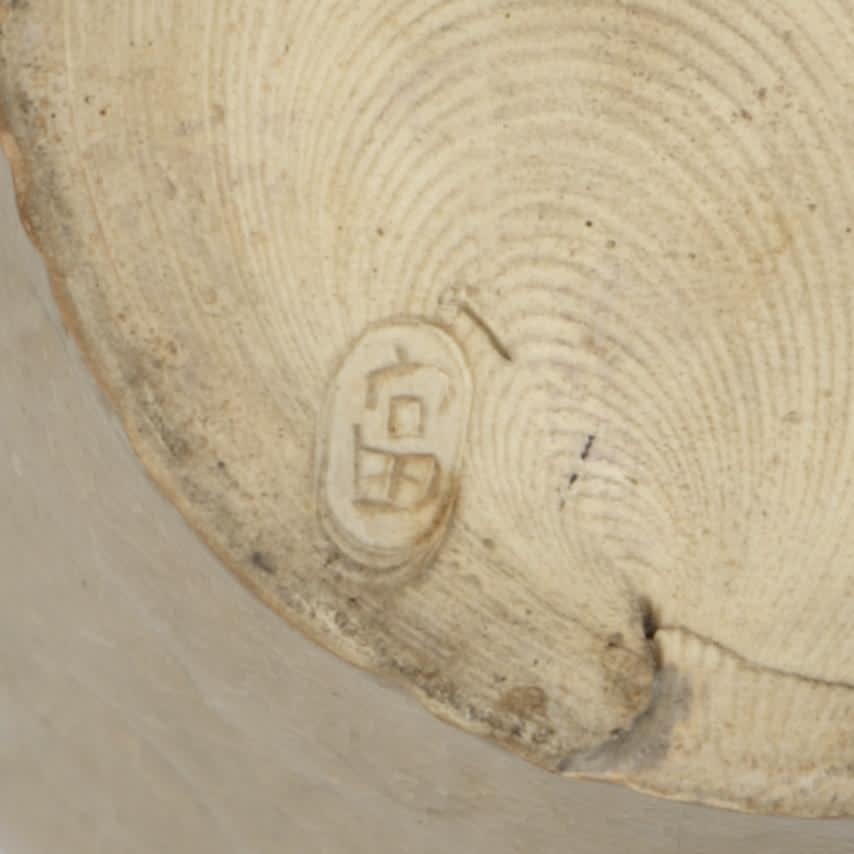Tomimoto Kenkichi (1886–1963)
Ornamental Vase
Sealed “Tomi” on foot
With a box signed by the artist
W19 x H25.7 cm
Further images
The box accompanying this work bears a note in Tomimoto’s own hand stating that the jar is an “old piece from [his] Yamato period,” referring to the years between 1915, when he established his first kiln near his birth home in Ando, Nara prefecture (formerly Yamato province), and around 1926, when he moved to Tokyo. In addition, the inscription also suggests that he did not throw the piece on the wheel himself. It is known that, in the beginning of his Yamato period, Tomimoto employed artisans from Kyoto to do wheelwork for him and the box inscription seems to indicate that this piece was produced under such circumstances. The potter’s first ceramics were produced in the raku style, but in his Yamato period he began to experiment in higher-temperature firing in order to produce more functional pottery. For these pieces, which he referred to as tsuchi-yaki (“fired earth/clay”), he used clay obtained from the village’s “lower reservoir” and it is said that, even after he moved to Tokyo, Tomimoto continued to send away for this clay, which he described as “taking on a pale green color when reduction fired and assuming a pale red color when oxidation fired, much like Korean Gyeryongsan ware.”
This jar is decorated with swirls and various other patterns carved into the pale green surface of the body of the piece. Perhaps because of the way the glaze is applied, it appears a grayish-white in some places and one can imagine that Tomimoto may have been testing out different patterns and firing effects. Although it is a simple, unsophisticated form, this is a piece filled with a profound appeal that reflects the foundational base of Tomimoto Kenkichi’s work as a potter.
Tomimoto Kenkichi (ceramist; 1886–1963)
Nara-born ceramist. Graduated from graphic design at the Tokyo Fine Arts School. Closely acquainted with Bernard Leach after his studies in Britain. Built kiln in his hometown, and learned various techniques from kilns in different regions. His distinctive aesthetics are reflected in his white porcelain, underglaze blue and overglaze enamel works, corresponding to the “artist of patterns” as he is often regarded. Appointed Tokyo Fine Arts School and Kyoto University of Arts professor. Received the Order of Culture. Designated as a holder of Important Intangible Cultural Property (overglaze enamel ceramics).
This jar is decorated with swirls and various other patterns carved into the pale green surface of the body of the piece. Perhaps because of the way the glaze is applied, it appears a grayish-white in some places and one can imagine that Tomimoto may have been testing out different patterns and firing effects. Although it is a simple, unsophisticated form, this is a piece filled with a profound appeal that reflects the foundational base of Tomimoto Kenkichi’s work as a potter.
Tomimoto Kenkichi (ceramist; 1886–1963)
Nara-born ceramist. Graduated from graphic design at the Tokyo Fine Arts School. Closely acquainted with Bernard Leach after his studies in Britain. Built kiln in his hometown, and learned various techniques from kilns in different regions. His distinctive aesthetics are reflected in his white porcelain, underglaze blue and overglaze enamel works, corresponding to the “artist of patterns” as he is often regarded. Appointed Tokyo Fine Arts School and Kyoto University of Arts professor. Received the Order of Culture. Designated as a holder of Important Intangible Cultural Property (overglaze enamel ceramics).







